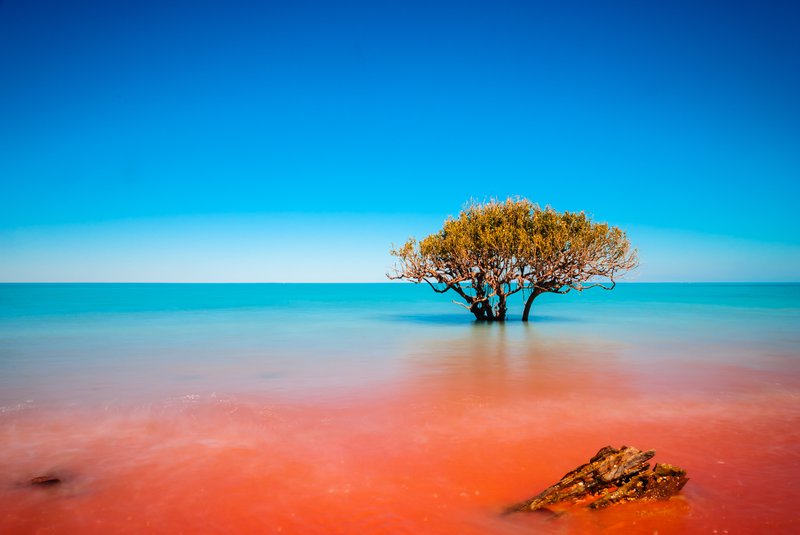Wanderlust Series: Because Travel and Real Estate go hand-in-hand
At RT Edgar, we pride ourselves on understanding our clients beyond the realms of real estate. Many of you are inspired travellers, and by connecting with you, we've discovered not only where and how you want to live, but also where and how you choose to travel. In this Wanderlust series, we delve into the world’s most captivating destinations and explore how cherished experiences and adventures interweave with real estate aspirations.
Remote, unique, and awe-inspiring, the allure of the Kimberley is multifaceted and powerful. Geographical features such as rock formations, gorges and waterfalls attract travellers from all over the world, while ancient Indigenous rock art has revealed the rich history and culture behind the people who created it. The region’s sheer natural beauty, created by the juxtaposition of vibrant colours as turquoise waters lap against ochre cliffs, and tangerine sunsets give way to inky star-lit skies make the Kimberley a must-see destination.
When to go
Visiting one of the world’s most remote regions, which is subject to annual flooding and monsoons, takes much planning and forethought. The travel season for the Kimberley is relatively short, running from May to early September. Many tours and cruises are booked out at least a year in advance.
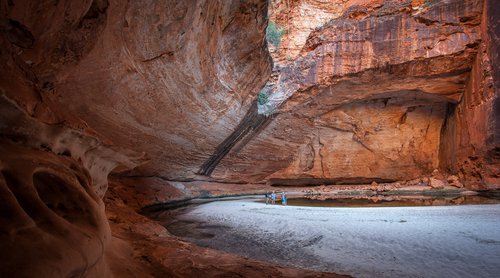
Nature's masterpiece – Cathedral Gorge.
Cruise or Tour?
While most organised touring through the Kimberley has traditionally been by 4WD vehicle, cruising has recently gained popularity as a fabulous way to see the wonders of the Kimberley coast and visit places inaccessible by land. Whale watching is also a bonus of cruising as humpbacks and southern rights make their way to their breeding grounds during the season. If you choose an organised 4WD tour, it’s best to travel with a reputable company with many years of experience and look out for EcoStar accreditation on tours and accommodation listings.
What to see
Come face-to-face with the world’s oldest rock formations and discover what billions of years of pressure, wind and water have left behind. Known to the Indigenous people for more than 40,000 years, the unique beehive-shaped striped domes of the Bungle Bungle Ranges were ‘discovered’ by a non-Indigenous film crew in 1983 and revealed to the world soon after. They have since become the Kimberley’s number one attraction.
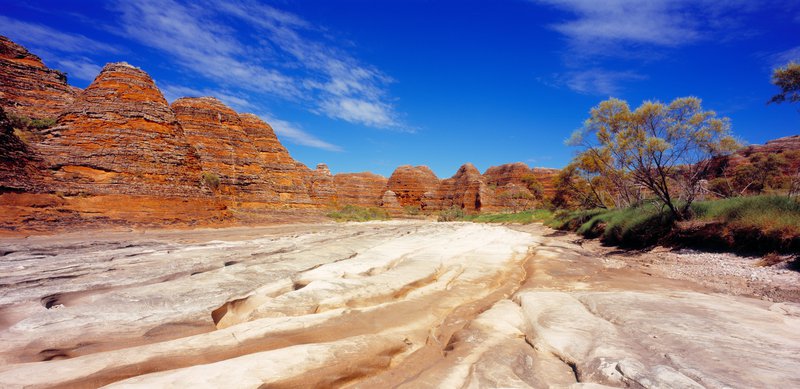
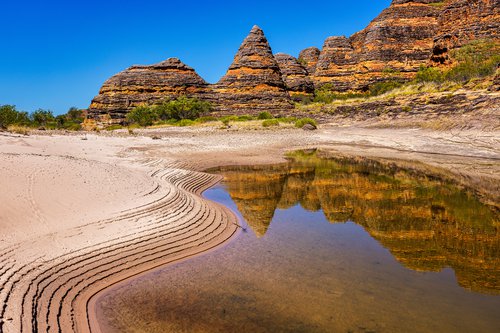
The stunning rock formations of the Bungle Bungle Ranges.
Famous for its luxury homestead accommodation, El Questro Station also offers camping sites and cabins and is an excellent launch pad to visit some of the Kimberley’s most stunning water holes including Emma Gorge and the thermal waters of Zebedee Springs.
Talbot Bay, part of the 1,000 islands of the Buccaneer Archipelago is where you’ll find Horizontal Falls an aquatic phenomenon caused when the powerful tides rush between a narrow channel creating rapids.
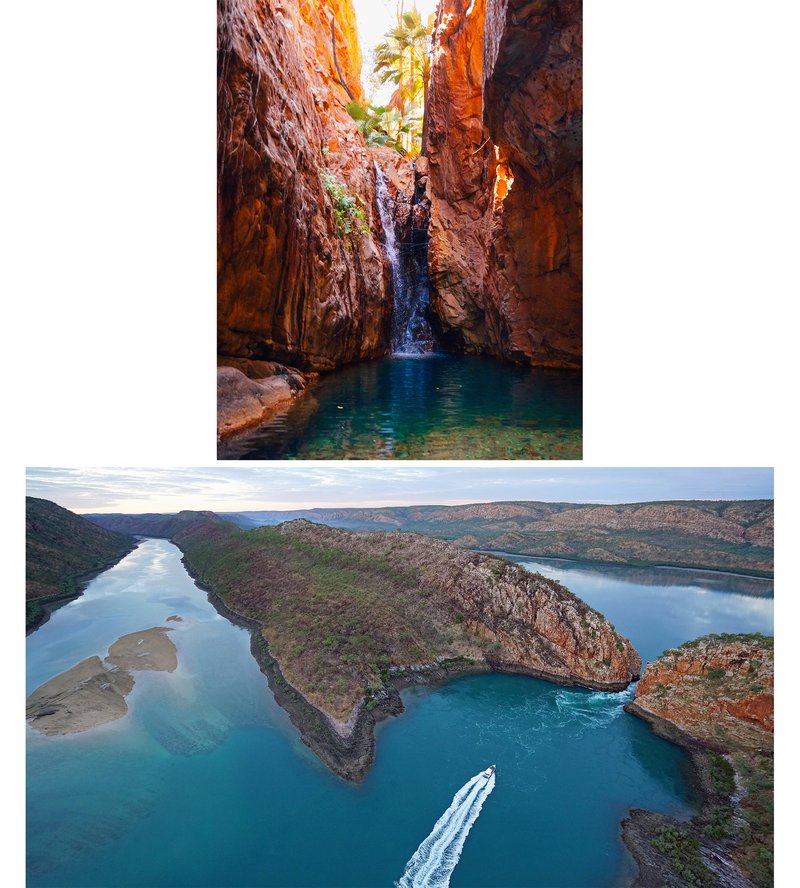
Top: El Questro. Above: Aerial views of Horizontal Falls.
Also part of the Buccaneer Archipelago, and inaccessible by road, Western Australia’s highest twin waterfalls, the King George Falls can only be seen from the air on a scenic flight or the coast as part of a cruise. Watch in awe as the King George River plunges over an ancient sandstone cliff in the North Kimberley Marine Park.

King George Falls, a mesmerising display of cascading waters and towering cliffs.
The area known as Munurru, close to the King Edward River on the Mitchell Plateau, is the most revered location to explore Wandjina and Gwion Gwion rock art. The best way to discover the stories behind the art’s symbolism and history is with an Indigenous guide.
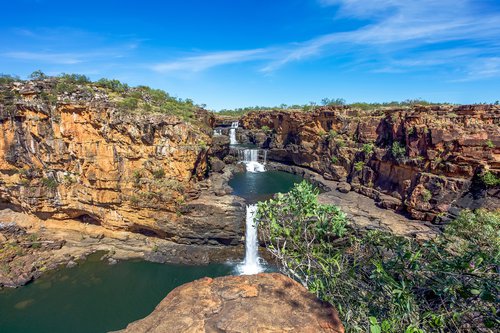
The thundering falls at Mitchell Plateau.
Check your calendar to see if there is going to be a full moon whilst you are away. If so, you may get to see the ‘Staircase to the Moon’. This awe-inspiring natural phenomenon occurs when the full moon rises over the exposed tidal flats of the Kimberley. One of the best places to see it is in Roebuck Bay in Broome.
How to get there
Whether travelling by land or sea on a 4WD adventure or a small ship expedition cruise, most Kimberley tours begin or end in the historic pearl diving town of Broome, famous for its Cable Beach sunsets. It’s worth noting that Qantas is the only airline currently providing direct return flights between Melbourne and Broome on just three days per week during the season. A non-direct flight will mean a transfer in Perth and travel times can be long!

Camels traversing Cable Beach at sunset.
What to pack?
Sunscreen, hats, sunglasses, sturdy walking shoes, shoes you can wear in the water and rockpools, comfortable cotton clothing with long sleeves and insect repellent. You’ll also need at least one jumper or jacket, as it can get chilly at night, especially when the sky is clear and illuminated with billions of stars. And don’t forget your sense of adventure.
